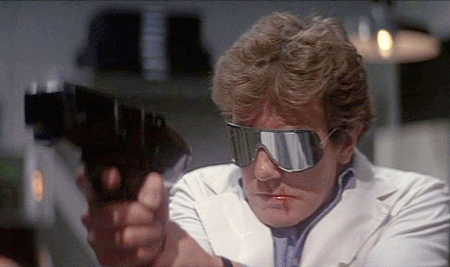Retro Futures: “Looker” (1981), looking back, looking forward
42 years ago, a murder mystery predicted digital twins and deepfakes: what did this howlingly bad movie get right and wrong?
By Brad Berens
Writing science fiction is a what if? exercise that tells us a lot about the moment when the writer first posed the question. Looking at where those predictions went awry can help us to understand where we are today and also where we’re headed.
 In the 1940s, thinking about the spread of totalitarianism, George Orwell asked himself “what if this all goes horribly wrong?” and wrote 1984. In the 1960s, thinking that things were improving, Gene Roddenberry asked himself, “what if this all goes terrifically right?” and created Star Trek. In the 1980s, Margaret Atwood asked herself, “what if Roe v. Wade isn’t as settled as we think?” and wrote The Handmaid’s Tale, which proved disturbingly prescient.
In the 1940s, thinking about the spread of totalitarianism, George Orwell asked himself “what if this all goes horribly wrong?” and wrote 1984. In the 1960s, thinking that things were improving, Gene Roddenberry asked himself, “what if this all goes terrifically right?” and created Star Trek. In the 1980s, Margaret Atwood asked herself, “what if Roe v. Wade isn’t as settled as we think?” and wrote The Handmaid’s Tale, which proved disturbingly prescient.
At a smaller, tech-focused scale, Michael Crichton’s 1981 movie Looker asked, “what if we could create completely accurate digital copies of people and then use those copies instead of the originals?” Today, we call those technologies digital twins (usually this refers to products, not people) and deepfakes (this has a malicious connotation with things like revenge porn).
Nobody should watch this terrible movie. You don’t have to take my word for its epic badness. Just watch the trailer:
By the way, this is not one of those “it’s so bad it’s good,” MST3K movies. It’s just bad… 93 minutes long, but it feels like 193. (If you are a cinematic masochist, then you can rent the movie for $2.99 on Amazon.)
What Happens in Looker
Our action heroes are a middle-aged Beverly Hills plastic surgeon (Albert Finney) and a pretty but dim young model (Susan Dey). Finney’s Dr. Larry Roberts has performed a series of operations (including on Dey’s Cindy Fairmont) to amend tiny defects in beautiful women to make them “perfect.” Then the models start dying, all apparent suicides.
We learn that the Reston Corporation (James Coburn plays billionaire industrialist bad guy John Reston) has asked the women to get plastic surgery in service of a new technology.
Digital Matrix—a gigantic collection of scanning and rendering hardware in a big lab—digitizes the models in order to put them into the perfect pose in the perfect shot every time. The models agree to digitization in exchange for $200,000 per year in perpetuity. However, the Reston Corporation does not want to pay the money, and so it arranges to kill the models after scanning them. Using a “Light Ocular-Oriented Kinetic Emotive Responses” (L.O.O.K.E.R.) device that mesmerizes the models, Reston’s pet thug (known only and hilariously as Moustache Man) stages their suicides.
The key difference between where Looker thought things were going and where we are today is distribution. In the movie, a big, multi-billion-dollar corporation builds technologies that nobody else has and then uses them nefariously because that’s what corporations in movies (and sometimes in reality) do. Today, corporations create platforms that distribute technologies to many users, most of whom use the technologies for innocuous purposes. Some are nefarious.
The Reston Group is also integrating the L.O.O.K.E.R. technology into its ads in order to persuade consumers to buy their products, so Looker is also a movie about the evils of advertising a la Vance Packard’s 1957 aria of paranoia, The Hidden Persuaders.
The L.O.O.K.E.R. device has nothing to do with the digital twinning technology, so the entire murder mystery is a head fake to distract the audience from realizing that a glorified scanner isn’t a great basis for an action movie.
Finney and Dey have zero chemistry, so when they agree to date at the end it’s the least believable thing in the movie. Finney, who crackled with charisma as Daddy Warbucks in Annie a year later, seems old and tired (he was 45). His pulse never cracks 60, even during a fight scene. Dey’s nude scene electrified teen boys at the time (Laurie Partridge is naked!) and is the main reason the movie got a theatrical release rather than what it deserved, which was to be a TV movie of the week.
Looker is a terrible movie, but it contains provocative predictions.
Retro Futures: what Looker gets right and wrong
The L.O.O.K.E.R. device is a Hitchcockian MacGuffin, a plot accelerator that you don’t need to take seriously.
The Digital Matrix scanning technology is a serious prediction. The movie nails that digital information is easier to manage and transform than its analog counterpart. It also accurately observes that once information is digital people can use it or misuse it for purposes other than the original plan. In this, Crichton was decades ahead of his time.
The key difference between where Looker thought things were going and where we are today is distribution. In the movie, a big, multi-billion-dollar corporation builds technologies (the scanner and the mesmerizer) that nobody else has and then uses them nefariously because that’s what corporations in movies (and sometimes in reality) do. The corporation has a moat around its technologies—it’s a command-and-control exercise.
Today, corporations create platforms that distribute technologies to many users, most of whom use the technologies for innocuous purposes. Some are nefarious. The corporations often turn a blind eye to their bad users (e.g., Facebook not paying attention to Cambridge Analytica until it was too late) because more users mean more profits.
With off-the-shelf computers, today’s malicious perpetrators of, for example, deepfake porn put celebrity faces onto naked bodies doing things the celebrities wouldn’t do on camera. The deepfakers are anonymous, not part of a big corporation that’s easy to find.
This is a common trend in the tech journey from science fiction to everyday reality: centralization yields to massive distribution, and then massive distribution leads to innovation both moral and immoral. Getting back to Orwell, 1984 imagined Big Brother controlling everything. However today, as Simson Garfinkel famously observed in Database Nation, “it is instead a future of a hundred kid brothers that constantly watch and interrupt our daily lives” (page 3). Surveillance is distributed.
Over the last few years, I’ve explored Retro Futures because older science fiction can help us make more accurate predictions about our own futures, and it can also help us to stay humble because nobody gets everything right.
__________

Brad Berens is the Center’s strategic advisor and a senior research fellow. He is principal at Big Digital Idea Consulting. You can learn more about Brad at www.bradberens.com, follow him on Post and/or LinkedIn, and subscribe to his weekly newsletter (only some of his columns are syndicated here).
See all columns from the Center.
February 3, 2023


